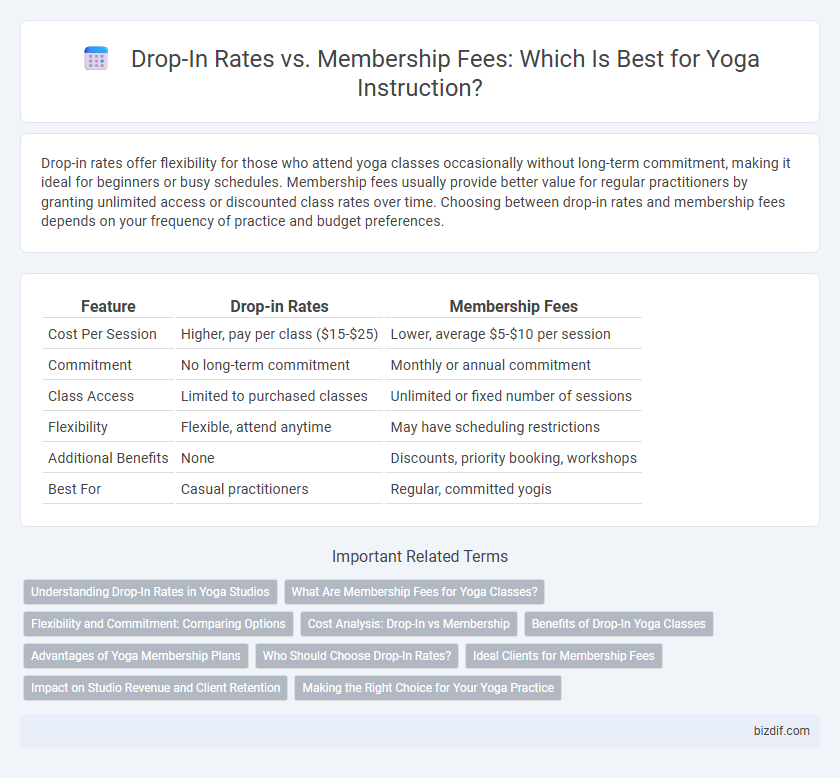Drop-in rates offer flexibility for those who attend yoga classes occasionally without long-term commitment, making it ideal for beginners or busy schedules. Membership fees usually provide better value for regular practitioners by granting unlimited access or discounted class rates over time. Choosing between drop-in rates and membership fees depends on your frequency of practice and budget preferences.
Table of Comparison
| Feature | Drop-in Rates | Membership Fees |
|---|---|---|
| Cost Per Session | Higher, pay per class ($15-$25) | Lower, average $5-$10 per session |
| Commitment | No long-term commitment | Monthly or annual commitment |
| Class Access | Limited to purchased classes | Unlimited or fixed number of sessions |
| Flexibility | Flexible, attend anytime | May have scheduling restrictions |
| Additional Benefits | None | Discounts, priority booking, workshops |
| Best For | Casual practitioners | Regular, committed yogis |
Understanding Drop-In Rates in Yoga Studios
Drop-in rates in yoga studios typically provide flexibility for occasional practitioners, allowing access to single classes without a long-term commitment. These rates are often higher per session compared to membership fees, which offer cost-effective options for frequent attendance through monthly or yearly plans. Understanding drop-in rates helps students evaluate the value based on their practice frequency and budget constraints.
What Are Membership Fees for Yoga Classes?
Membership fees for yoga classes provide unlimited or discounted access to a series of sessions over a set period, offering cost savings compared to paying individual drop-in rates. These fees often include additional benefits such as priority booking, access to exclusive workshops, and use of studio facilities. Investing in a membership supports consistent practice, which can lead to improved flexibility, strength, and mental well-being.
Flexibility and Commitment: Comparing Options
Drop-in rates offer maximum flexibility, allowing yoga practitioners to attend classes without any long-term commitment or recurring fees, ideal for those with unpredictable schedules. Membership fees provide better value for regular attendees, granting unlimited access to classes and fostering a consistent practice that supports skill progression and community building. Choosing between drop-in rates and memberships depends on individual commitment levels and usage frequency, balancing cost-efficiency with convenience.
Cost Analysis: Drop-In vs Membership
Drop-in rates for yoga classes typically range from $15 to $25 per session, offering flexibility for occasional practitioners without long-term commitments. Membership fees, averaging between $80 and $150 monthly, provide unlimited access, making them more cost-effective for frequent attendees attending more than four classes monthly. Evaluating personal attendance frequency and budget preferences is essential for choosing between drop-in rates and membership plans to maximize value.
Benefits of Drop-In Yoga Classes
Drop-in yoga classes offer flexible scheduling and affordability, allowing practitioners to attend sessions without long-term commitments or upfront membership fees. This option appeals to individuals seeking variety and the freedom to explore different instructors and styles without being tied to a fixed plan. Drop-in rates provide convenience for those with unpredictable schedules, making it easier to maintain a consistent practice on their own terms.
Advantages of Yoga Membership Plans
Yoga membership plans provide cost-effective access to a variety of classes, promoting consistent practice and long-term wellness benefits. Members enjoy priority booking, exclusive workshops, and often discounted rates on special events, enhancing overall value. Committing to a membership encourages accountability and deeper engagement with instructors and community, fostering a more rewarding yoga experience.
Who Should Choose Drop-In Rates?
Drop-in rates offer flexibility for individuals with unpredictable schedules or those new to yoga seeking to test different classes without commitment. They are ideal for occasional practitioners who prefer paying per session instead of long-term membership fees. Drop-in options also benefit travelers or visitors wanting access to high-quality instruction without financial ties.
Ideal Clients for Membership Fees
Ideal clients for yoga membership fees are often regular practitioners seeking consistent access to classes and added benefits like workshops or private sessions. Membership plans provide predictable monthly costs, fostering commitment and enhancing skill progression compared to sporadic drop-in rates. These clients value long-term wellness investment and often experience greater motivation and community support.
Impact on Studio Revenue and Client Retention
Drop-in rates provide flexible access attracting occasional visitors but result in inconsistent studio revenue and lower client retention. Membership fees offer predictable income streams and encourage regular attendance, enhancing long-term client loyalty. Balancing both pricing models optimizes revenue stability while fostering sustained engagement and growth.
Making the Right Choice for Your Yoga Practice
Choosing between drop-in rates and membership fees for yoga classes depends on your practice frequency and budget. Drop-in rates offer flexibility for occasional visits, while membership fees provide cost savings and consistent access for regular practitioners. Evaluating your commitment level and class attendance helps determine the most beneficial financial option for sustaining your yoga routine.
Drop-in rates vs Membership fees Infographic

 bizdif.com
bizdif.com